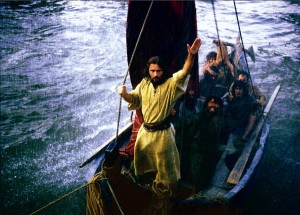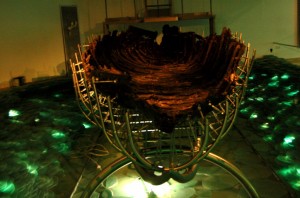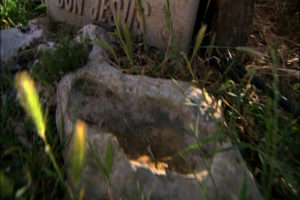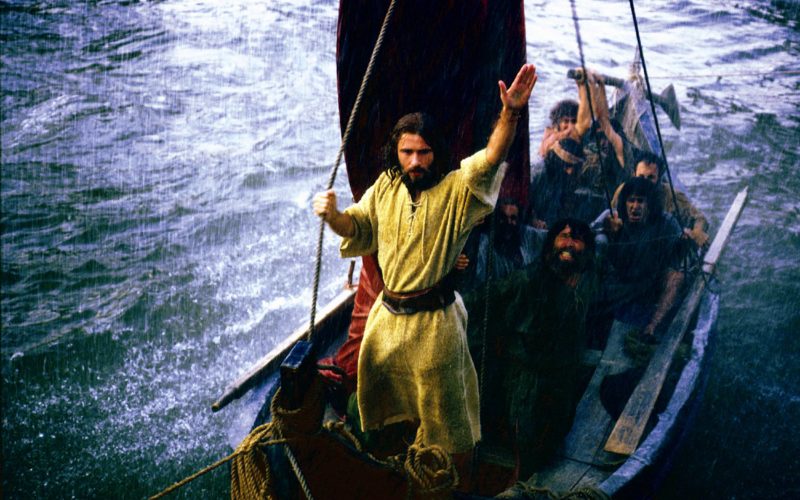The Lost Tribe of Gad – Found!
Decoding the Gospels may provide us with a map to one of the lost tribes of Israel.
The Gospels record a stormy sea journey to a mysterious place called “The Land of the Gadarenes” (Matthew 8:28-34, Mark 5: 1-20, Luke 8: 26-39). As the story goes, all the disciples are with Jesus on a boat, when they are caught in a terrible storm. Jesus ignores the storm, sleeping right through it. When he’s awakened, he calms his disciples and proceeds to calm the storm.

This story is very important for Christian theology because it argues that Jesus had mastery over nature. When they get to where they were heading, Jesus meets one or two (depending on the Gospel) “demonics” i.e., possessed men. These were living in tombs, in a necropolis by the sea. Here, Jesus performs another one of his famous miracles, namely, he makes the demons leave the possessed men and proceeds to zap them into a herd of 2,000 domesticated pigs. The possessed pigs now take a swine-dive to their death, off a cliff into the sea below. The neighbouring Gadareans come out, hear the story from the demonics, and immediately tell Jesus to get back on the boat and leave. After all this, Jesus comes back to great fanfare – thousands are waiting for him on the beach.
The traditional view is that all this happened on Israel’s Lake Kinneret, known in English as the “Sea of Galilee”. According to the traditional Christian view, Jesus crossed the tiny Galilean lake to the other side, landed in what is today Kursi and then proceeded to perform his miracles with the demonics and the swine. There’s a byzantine monastery commemorating the event at Kursi, and a nearby cave has been designated as the “cave of the demonics”.

Lately I’ve been reading Porphyry’s “Against the Christians”. Porphyry of Tyre, in modern Lebanon, was a pagan philosopher who lived between 232 CE and 305 CE. In 448 CE, Porphyry’s polemic against Christianity was condemned to be burned by the church. Recently, bits and pieces of the text have been gathered together in an attempt to recreate the now lost critique. Writing on the Jesus episode with the demonics, Porphyry casts doubt on the whole story: “There is no ‘Sea’ in the locality [i.e., the Galilee],” he says, “but only a tiny lake which springs from a river that flows through the hills of Galilee near Tiberius. Small boats can get across it in two hours and the lake is too small to have seen whitecaps caused by a storm.”
In other words, more than 1,800 years ago, people understood that Jesus’ voyage to the land of the Gadareans could not have taken place on the Sea of Galilee. It’s something that makes no sense. How could you fall asleep in a tiny fishing boat during a storm? There is nowhere to sleep, and no way to sleep. If you lay across some rope, you would constantly be splashed in the face from the stormy spray. Furthermore, as Porphyry points out and as others, like the French philosopher Voltaire later remarked; what are pigs doing in the Jewish state? There are also no cemeteries on the shores of the Sea of Galilee, nor any tombs you could live in. There are no cliffs and there’s no “Land of the Gadareans”. There was a Gedara further inland, but it had no access to the lake. Put differently, there are no tombs, there’s no necropolis, no swine, no cliffs, no nothing. Either the story didn’t happen or the “sea” that Jesus was sailing was not the tiny Galilean lake.
Some people say that since there was a confederation of non-Jewish cities on the east side of Jordan called the Decapolis, Jesus must’ve been sailing there. This is a way of justifying the swine. But the whole story doesn’t fit. You can jog from Capernaum (Jesus’ HQ in the 1st century) to Kursi in a matter of minutes, at most hours. Nothing – I repeat – nothing fits – not the geology, and not the archeology.
But there is a sea that fits the body of water in this story. It’s the Mediterranean Sea. In this story, Jesus is clearly emulating the prophet Jonah, who sailed from Jaffa on his way to Tarshish i.e., ancient Tartessos in Spain, before being notoriously swallowed by a large fish. Jonah also fell asleep on the boat and calmed the sea by having the sailors toss him into the raging waters. In other words, if Jesus was following in Jonah’s footsteps, he would’ve left Jaffa and sailed towards Spain, across the Mediterranean. Once you realize that this is in fact where Jesus was sailing, a long lost voyage comes clearly into focus.

Everything fits. The boats plying the waters are big enough for someone to fall asleep in the hold. Off the Spanish peninsula, there are constant storms near the Balearic Islands. There are ancient cemeteries right on the shore made up of tombs big enough for living men to live in. There are cliffs e.g., Gibraltar, and to this day there’s plenty of swine – the famous black pork of southern Spain. Everything fits and there’s a tradition on the island of Majorca that Jesus made landfall there.
So what gives, why has Spain been covered up and substituted with the Sea of Galilee? Because Jesus failed in his mission. The Gadareans did not follow him. They chased him out of town. So the story had to shift from the arena of failure to the arena of success. In any event, whatever the theological reason for the Gospels’ slight of hand, the fact is: Jesus sailed to Spain.
Since many people believe that Jesus occupied some kind of mythical time and space, the idea of his voyage to Spain sounds impossible. Most people have a quaint perception that Jesus spent his entire “ministry” – prior to going to Jerusalem where he was crucified – in northern Israel, walking along the shores of the “Sea of Galilee”. But is this historical reality or theological fantasy? Did Jesus really spend his entire life in Israel? Or did he travel elsewhere, namely, Spain? I’m sure this theory sounds farfetched, especially if you believe that the ancients couldn’t travel. But is this gut feeling historically accurate?

The fact is that Santiago de Compostela, in Galicia in northwestern Spain, is one of the three most important pilgrimage sites for Christians (the other two being Rome and Jerusalem). Traditionally, it’s the place where James, one of Jesus’ twelve apostles, is buried. If James could make it to Spain, why not Jesus? The apostle Paul also declares his intention of traveling to Spain (Romans 15:24), and some Christian traditions say that he made it there. Put differently, if Paul and James could travel to Spain, why not Jesus?
So why would Jesus travel to Spain? Because it was part of the job description of the Messiah to ingather the “lost sheep of the house of Israel” i.e., the so-called lost tribes of Israel, and bring them home. If he thought of himself as Messiah, Jesus would’ve wanted to – at least symbolically – ingather the lost tribes. According to the Jewish historian Josephus, during his lifetime in the 1st century, the whereabouts of the exiled tribes was known. One of the lost tribes i.e., one of the tribes exiled from Israel by the Assyrians in the 8th century BCE, was the tribe of Gad. Is it a coincidence that the word “Gad”, “Guad” in Spanish, appears everywhere embedded in the geography of southern Spain e.g., Gaudalete, Gaudalquivir and Guadiana. More than this, ancient Cadiz was called “Gadir” – the land of the Gadareans. In Hebrew, “Gadir” means the city of Gad and, to this day, the citizens of Cadiz do not call themselves Cadizians, but “Gaditanos” i.e., Gadites. The long lost Gadites have been found.
Watch my film, “Secrets of Christianity“, and weigh the evidence.

